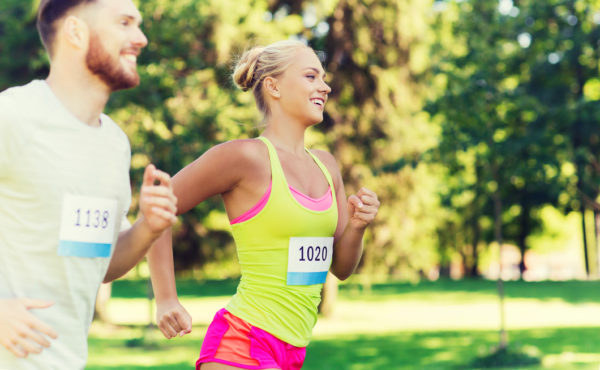Research has been showing that running may not be as hard on the joints as previously thought. Yes, when we run, we will have 2.5 times our body weight going through our lower limbs each time our foot strikes the ground, however our body has the amazing ability to adapt to the demands that we place on it. Many of the injuries that come from running are the result of chronic overloading and can be prevented with proper preparation and progression. Below are some of my favourite tips to help people get into running:

1 – Get fit to run, do not run to get fit. Before you start running, it is important to assess your mobility, stability and strength. Deficits in any of these areas do not mean that you cannot run, but may indicate that you need to speak to your health professional. They can guide you on some of the ways that you can improve in these areas in order to get the most out of your running and avoid injuries. Let’s talk about these 3 different aspects;
Mobility
You need enough mobility to get your leg behind you when you run. Typically, we look at mobility of the foot, ankle and hips. For instance, proper motion of the big toe is needed to push off the ground when you run. A good way to test this is to place your foot on the floor and lift your big toe. Ideally, you should be able to lift your toe 30 degrees, although 60 degrees is optimum. Many runners focus a lot on the mobility of their hamstrings and are concerned if they are not able to bend over and touch the floor. Surprisingly, some degree of stiffness in the back of the leg may be helpful, so focusing solely on stretching our hamstrings may not be as important as previously thought.
Stability
When we are assessing our patients prior to beginning a running program, we also need to look at stability. Some of the areas that we look at are the abdomen, low back, pelvis, hip, knee and foot.
Strength and power
This is mainly generated through the leg and hip. Some of the areas that we test are our calves, and the large muscles of our legs and pelvis. We might test this by having the person do a calf raise, where they stand on one foot and raise their heal off the floor and then slowly lower it. Ideally, we want our runner to be to be able to do 25 repetitions and be similar in ability on the left side as on the right. We might test the large muscles in the thigh by having our runner do a single leg chair sit, where they get out of a chair using one leg to push off and lower. Ideally, we want the person to be able to complete 20 repetitions and be similar in ability on the left leg as on the right.
2 – Try not to run on consecutive days. We all know that person who is so keen to get healthy and start their running program that as soon as the weekend comes, they go out running 3 days in a row. Then, they end up hurting and feel that running is not good for them. Try to give yourself a day of rest in between. Similarly, if you miss a run, try not to play catch up by doing multiple runs in a row.
3 – Increase in increments. Add to your distance slowly to allow your body to adapt to the demands that you are placing on it. Try to limit increasing your running distance by more than 10% each week. If you are new to exercise, consider walking first and progress to running in increments. There are some helpful apps that can help you come up with a program to increase slowly. The app “couch to 5K” or “couch to 10K” is one example. Or consider getting a coach who can help tailor a program to your needs, provide extra motivation and accountability.
4 – Vary your running surfaces. You may have heard the advice to avoid running on hard surfaces, and you may be surprised to learn that in the research, running surface has not been shown to influence injury rate. The reason for this is because our bodies can adapt to the running surface if given the chance. Most running injuries are repetitive strain injuries, so the more we can vary our running, the better. Mix some road running with trail running. Avoid going in the same direction on the same route over time, especially if the road is sloped. If you are a newbie, avoid running on sand to start with as it is more compliant and challenging to run on.
5 – Allow for arm swing. Arms should be comfortably bent at your sides and should not cross the midline when running as this increases the twisting movement in the low back and hips. Try to avoid carrying or holding items such as a dog leash or wearing your phone on an arm band, as all of these can change arm swing. A small pack around the waist is usually best. Try to keep the arms resting in that bent position to avoid tension in the shoulders and neck.
6 – Think “tall.” Pretend that you have a string attached to the top of your head which is pulling you up. Try to maintain an upright posture, to allow you to get the maximum air to your lungs. Try not to arch your back or run bent over.
7 – Pacing. It is not necessary to go hard all the time to get benefit from running. The 80:20 rule is a good one to follow. 80 percent of runs should be at a conversation pace where you are able to have a conversation with the person next to you, and the remaining 20 percent of your runs could be interval training at a higher intensity.
8 – Cadence. Time the number of times that your feet hit the ground in one minute. Ideally, we want to be about 170-180. For those with a lower cadence (less than 164), they tend to have a lot of excessive upward movement which is very inefficient and tends to create more impact through the body.
9 – Enjoy! By following these tips you should be well on your way to having an enjoyable and injury-free time running. Have a great run!
Dr. Alison Leitch practices at Noosa Holistic Health on the Sunshine Coast. She has completed a Doctor of Chiropractic Degree and an additional Health Science Degree. She has also completed the Medical Acupuncture Health Sciences program from McMaster University in Canada and is skilled in a variety to soft tissue techniques to address problems related to muscles, ligaments, nerves and fascia. Her clinical experience has been very diverse working with Olympic athletes, urban office workers and families of all ages. Dr. Alison’s area of focus is conditions related to the joints, spine, pelvis, nerves and muscles.




Leave A Comment